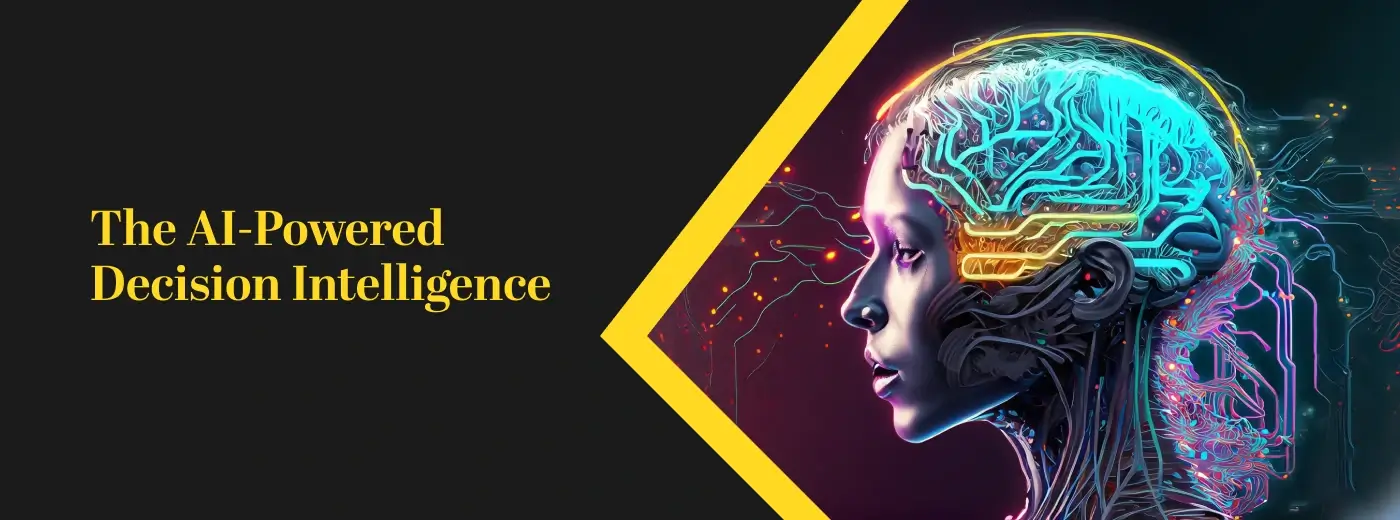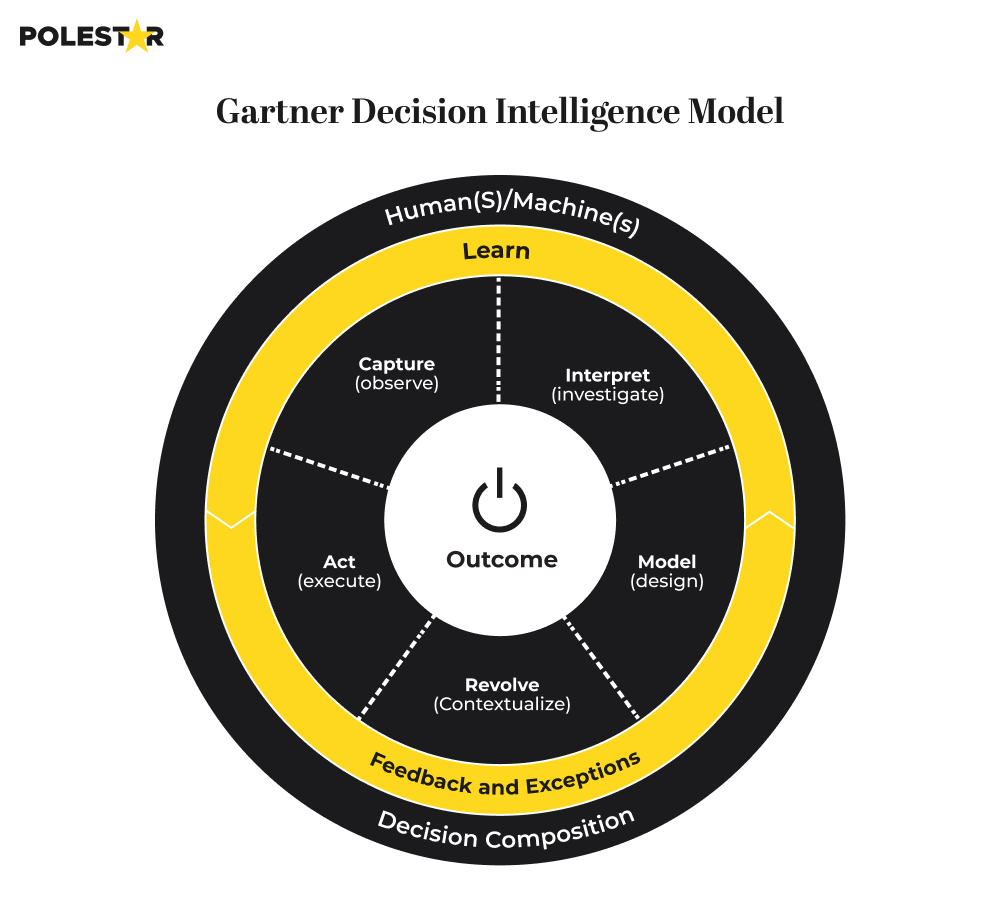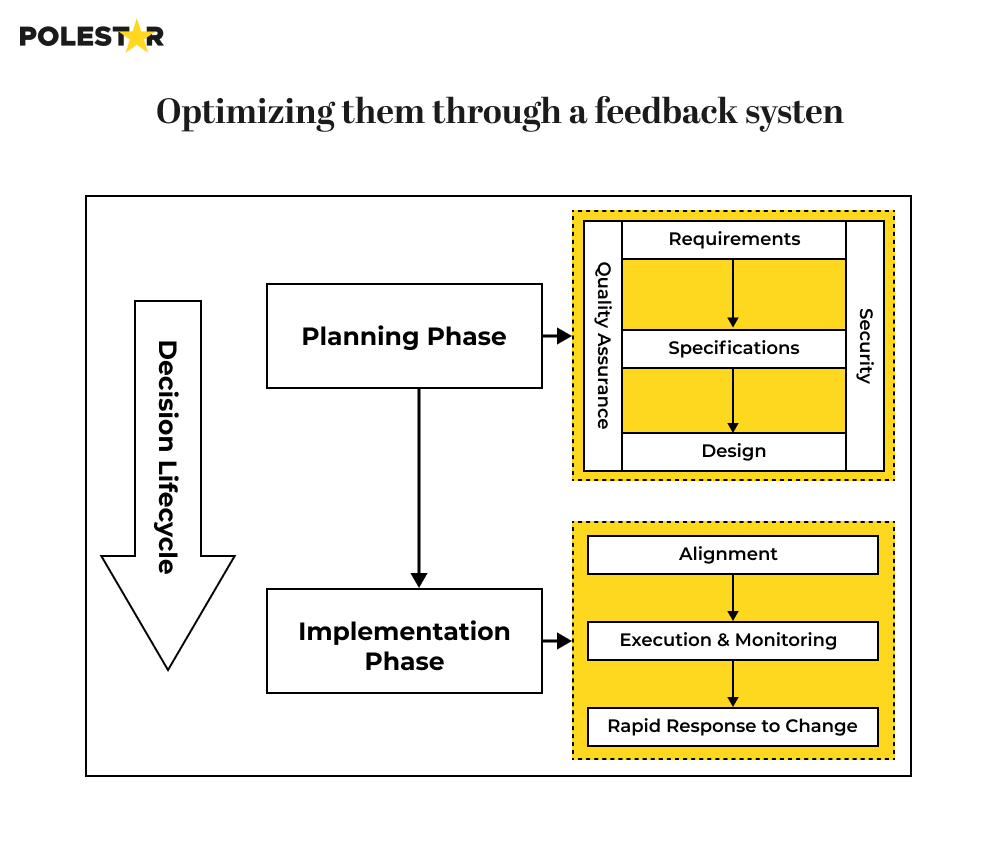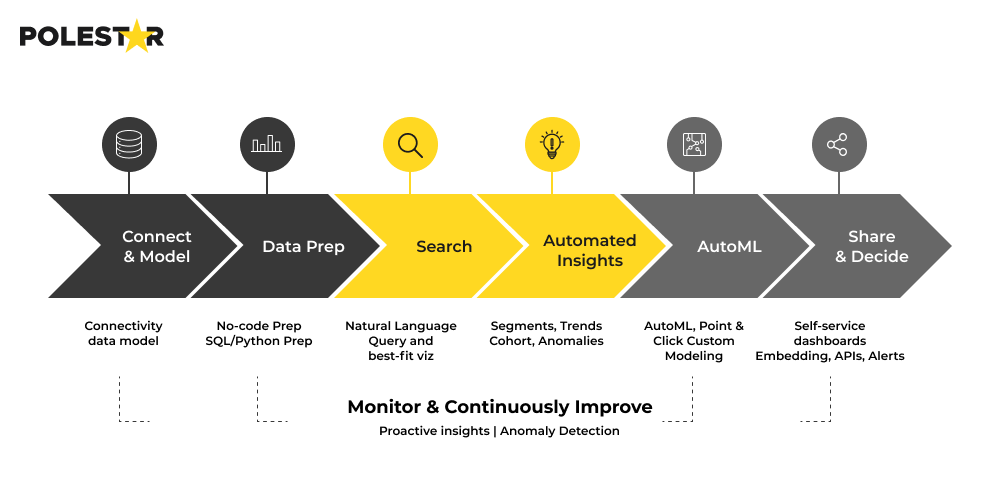
Sign up to receive latest insights & updates in technology, AI & data analytics, data science, & innovations from Polestar Analytics.
Editior's Note: This article delves into the transformative potential of decision intelligence, emphasizing its applications across industries like healthcare, retail, and banking. By showcasing decision intelligence use cases, it highlights how AI-driven tools are revolutionizing decision-making processes. From predictive analytics to decision automation, the insights provided here underscore the importance of embracing data-driven strategies for a competitive edge.
They say change is the only constant. If one does not plan to change, they are bound to fail. Some of the biggest corporations like Kodak, HTC, and Nokia have all fallen victim to changing dynamics. The root cause of failure? Poor decision-making. Businesses need guidance on where to invest their focus, decisions require in-depth knowledge and insights.
We all want to automate anything that is mundane, but in the age of AI, even dynamic functions such as decisions can have a sense of automation albeit not 100%. It has resulted in buzzwords like risk management and decision management solutions. These are assistive AI-based technology products that aid in strategic decision-making. At the end of the day you need to know how to improve decisions through decision intelligence.
How can AI show you the path and the logic behind each step?
How automation helps decision-making capabilities?
According to a Gartner survey, 50% of people said a good decision is defined by its outcome and 50% said it is determined by the process. The process is guided by reliable data and insights to take that decision. No matter how you look at it, at the end of the day, the only thing that you can control while making decisions is the data you feed into the system, be it an AI or a group of individuals.

Cost of Bad Decision Making
The average estimated cost of this lack of decision-making effectiveness for each enterprise in the Fortune 500 is $250 million per year[1], while the business impact of unmade or poorly-made decisions is over $4 trillion globally, every year.[2]
Big data, AI, and ML are powerful tools that can process unimaginable amounts of data in unrealistically fast timelines. That is why most enterprises have now set up departments solely focused on decision intelligence with AI. Let's take a look at how these models are able to process so much data in such short timelines. Most DI tools are based on Decision Mapping, which involves a systematic representation of decisions and their associated factors, assisting in the understanding and evaluation of outcomes.
Think of ML as a layer and a guide on top of Decision Mapping. Machine learning algorithms can be trained on large datasets to identify patterns and relationships among various decision variables. By analyzing historical data, these algorithms can learn from past decisions and their outcomes, enabling them to make predictions and recommendations for future decisions.
Automation further complements decision mapping by streamlining and accelerating the decision-making process. AI-powered systems can automate repetitive and time-consuming tasks involved in decision analysis, such as data collection, preprocessing, and analysis. This automation allows decision-makers to focus on higher-level tasks, such as interpreting results and considering strategic implications.
AI algorithms can monitor the impact of decisions and provide ongoing feedback. By continuously evaluating decisions against desired outcomes and adjusting strategies accordingly, decision intelligence with AI helps decision-makers stay agile and adapt to changing circumstances.

Nearly three billion business decisions are made annually, and research results by Bain show a 95% correlation between decision effectiveness and financial performance.
Integration with data warehouses and the utilization of AI-driven techniques can streamline the decision-making process. Advancements in NLP and embedding techniques enable decision-makers to generate meaningful insights from large volumes of data. By leveraging machine learning and automation, decision-makers can bridge the gaps between descriptive, diagnostic, and predictive analytics.
The amount of data that has to be processed for forecasting and making strategic decisions has surpassed the capabilities of the human mind. That is why Gartner predicted that by the end of this year, “more than 33% of large organizations will have analysts practicing decision intelligence, including decision modeling."
Decision Intelligence Use Cases
The limitations/ potential problems are-
Risks of biased decision-making: Ai is always as good as the data that it feeds on, though ML can help in becoming better at its job, the core information has to be unbiased. If the AI algorithms are trained on biased or incomplete data, they will generate unfair outcomes. Eg- in the movie coded bias, the protagonist explains how facial recognition Ai was not detecting dark-skinned people's faces due to a lack of that type of data being fed into the system.
Ethical implications: "Trolley problem" is a classic ethical dilemma where a hypothetical scenario involves a runaway trolley headed toward a group of people, and the AI must decide whether to divert the trolley to kill fewer people or maintain its course and harm more individuals. In the context of AI and decision-solving, this thought experiment highlights the challenge of programming machines to make ethically complex decisions.
Robust governance: This includes guidelines to address issues such as privacy, security, transparency, and accountability. It also involves establishing mechanisms for monitoring and auditing AI systems to detect and mitigate potential errors or biases.

These levels represent different degrees of AI involvement in the decision-making process.
Level 1. Decision Support: AI is utilized to provide insights, recommendations, and analysis to support human decision-makers. AI algorithms analyze data, identify patterns, and present relevant information to assist decision-makers in making informed choices. Decision support tools aid in data exploration, scenario analysis, and risk assessment.
Level 2. Decision Augmentation: Algorithms work collaboratively with human decision-makers, enhancing their capabilities. AI systems generate recommendations, but the final decision-making authority remains with the human.
Level 3. Decision Automation: Authority to make decisions autonomously based on predefined rules, algorithms, and models. This level is typically applied to routine, repetitive decisions.
The decision intelligence market is experiencing meteoric growth, with a projected value of $22.7 billion by 2027, reflecting a CAGR of 17.8% from 2022 according to market and markets. This expansion is driven by various tech-centric companies, including Google, which has established a team of 17,000 employees dedicated to decision intelligence.
Unilever and Reckitt Benckiser have already utilized DI technology to enhance their supply chain. As the data, insights, and analytics hype cycle matures, organizations are focusing on optimizing budgets and initiatives, emphasizing the importance of leveraging business-centric decision intelligence solutions like Peak, Sisu Data, Domo, Tellius, and Diwo.
Banking- Identify customers who might have trouble repaying their loans, allowing the bank to reach out and offer assistance before they default.
Healthcare- Identify patients who are at risk of developing certain diseases, helping healthcare organizations screen them early and provide preventive care. AI systems like Enlitic Cure analyze medical reports and suggest diagnoses to prioritize cases and improve medical outcomes.
Manufacturing- Identify potential defects in products, enabling companies to prevent or fix them before they reach customers.
Retail industry- Predict the best prices for products based on factors like customer demand and market trends, helping retailers optimize their pricing and supply chain.
Energy sector- AI software like Athena optimizes energy generation from sources like solar panels and predicts battery capacity requirements.
Electricity distribution operators in the Nordics use custom business analytics platforms to gather and analyze accurate data, generating reports for better decision-making.
Data quality: Taking data from various silos of an organization and cleansing it for modeling is a lengthy process.
Organizational change: DI is not a departmental-level transformation, hence enterprise-wide acceptance and willingness to change is preliminary.
Complexity: The 3 levels of DI require various tools and lengthy processing.
Testing: It is an iterative process and testing whether the tool AI variance is low is crucial.
Convention limits customization: There has to be a fine balance, the conventional approach might limit the usability and scalability whereas customization can increase the cost of deployment.
Vendor lock-in: These are long projects that might call for vendor lockins. Which can be a problem if the wrong vendor is chosen. Decision intelligence system can be a costly affair.
Polestar Analytics is at the forefront of this revolution, with industry expertise in all levels of DI, our team is dedicated to providing valuable transformation in this digital age.
In the near future, AI data-driven decision making solutions will be guiding our decision-making capabilities as well. The 3 levels of autonomous decisions making might be different but they all showcase the power that AI and hence DI holds in the long run. As a business leader, we help organizations set up their decision intelligence solutions. One should keep an eye on the next-gen tech. DI might just be around the corner.
About Author

Information Alchemist
Marketeer at heart, story creator by passion, data enthusaist by profession.